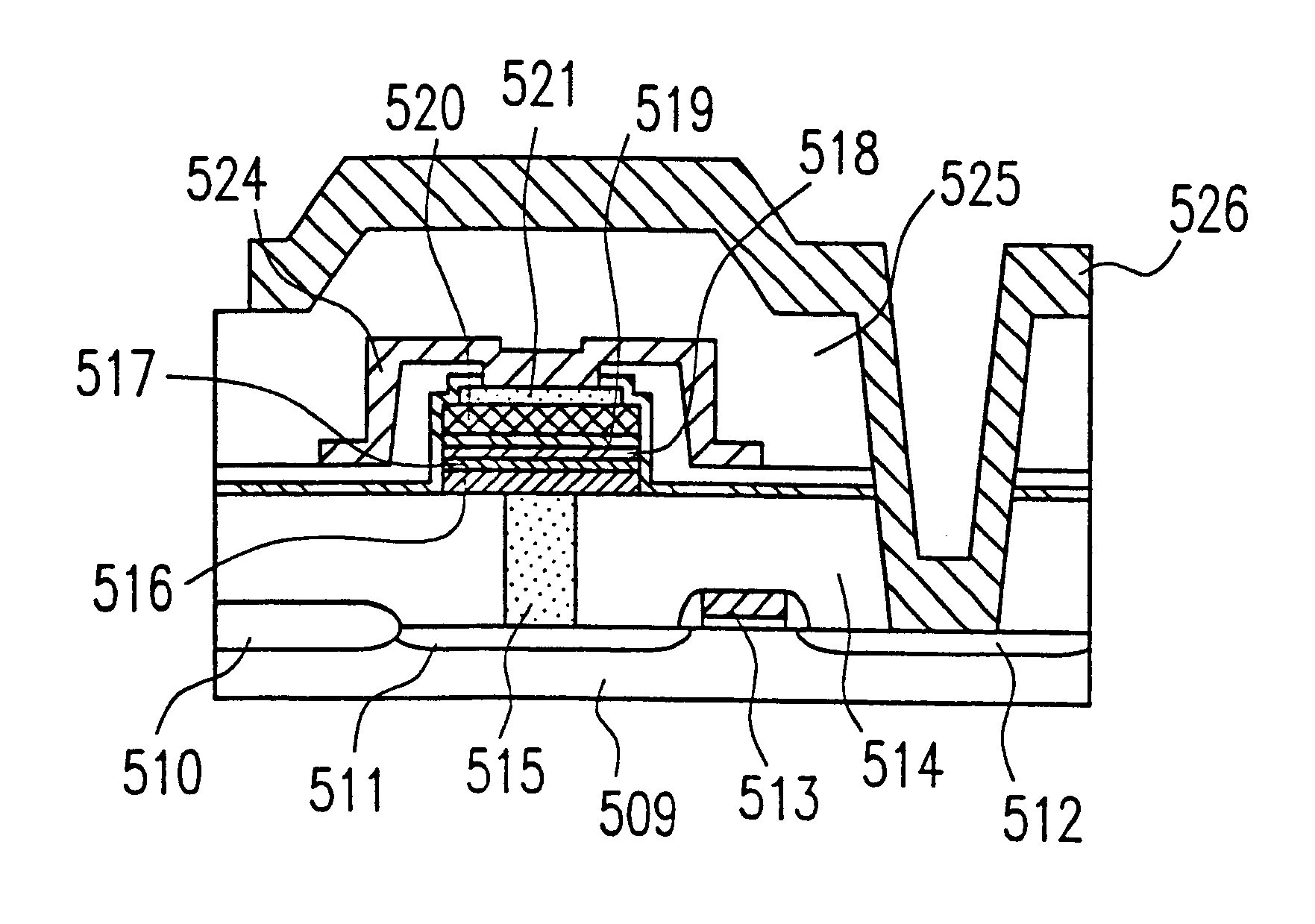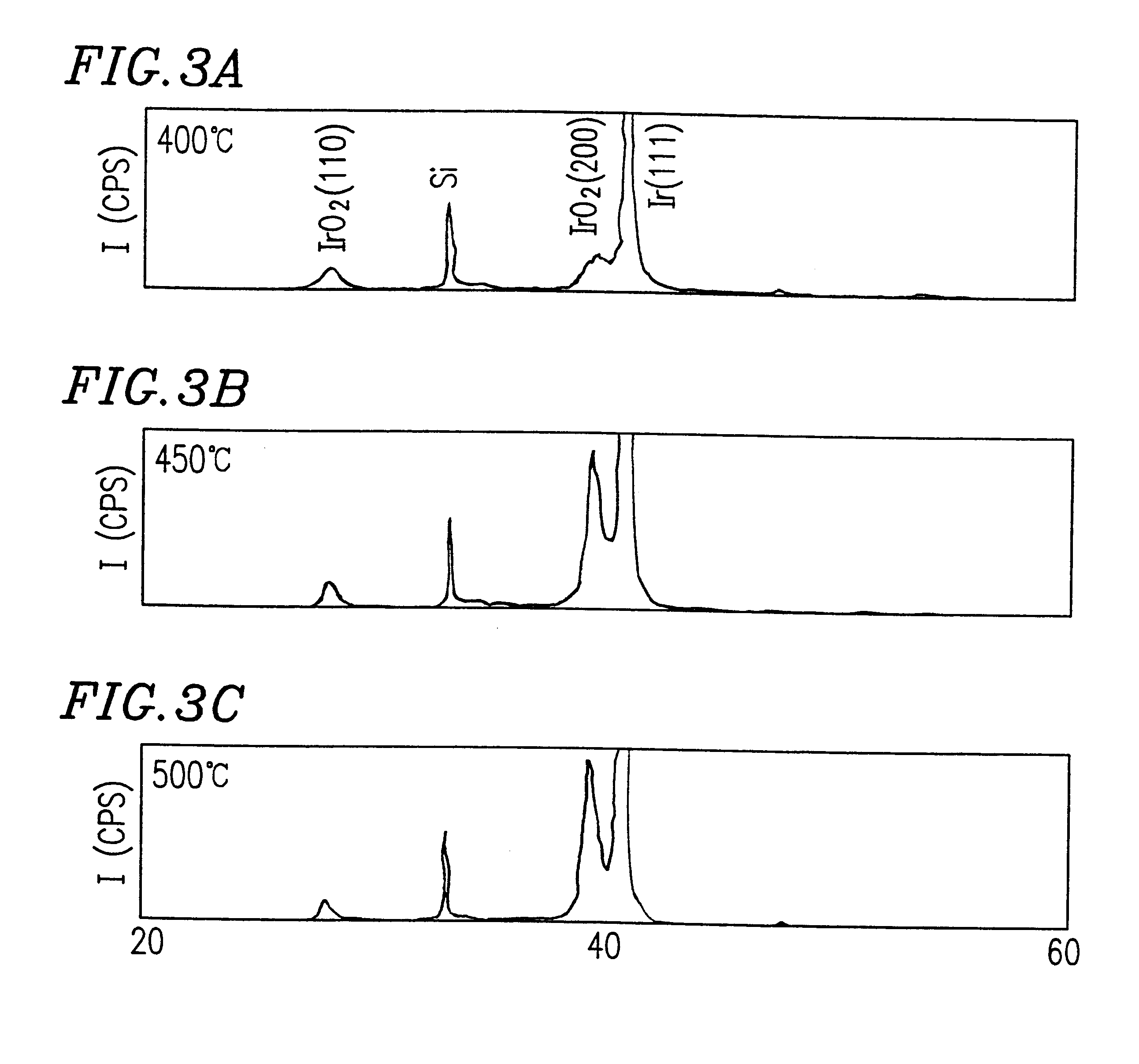Semiconductor memory device and production method of the same
a memory device and semiconductor technology, applied in the direction of semiconductor devices, semiconductor/solid-state device details, capacitors, etc., can solve the problems of long write time, affecting high-speed operation, and presenting a considerable problem
- Summary
- Abstract
- Description
- Claims
- Application Information
AI Technical Summary
Benefits of technology
Problems solved by technology
Method used
Image
Examples
example 2
(Example 2)
A process of producing a ferroelectric memory device according to Example 2 of the present invention will now be described with reference to FIGS. 7 and 8A to 8D.
First, a thermal oxide film (SiO.sub.2 film) 202 having a thickness of about 200 nm is formed on a silicon substrate 201 by heat-treatment in an oxygen atmosphere containing vapor at about 1050.degree. C. for about 20 minutes. Then, a Ti film having a thickness of about 20 nm is formed on the thermal oxide film 202 by sputtering Ti at a DC power of about 2 kW and a substrate temperature of about 400.degree. C. A closely contacting TiO.sub.2 film 203 having a thickness of about 40 nm is formed by thermally oxidizing the Ti film. Thereafter, a lower Pt electrode 204 having a thickness of about 200 nm is formed by sputtering Pt at a DC power of about 2 kW and a substrate Ad temperature of about 500.degree. C. Thus, a Pt / TiO.sub.2 / SiO.sub.2 / Si substrate as shown in FIG. 8A is prepared.
Then, an MOD solution of ferro...
example 3
(Example 3)
A process of producing a ferroelectric memory device according to Example 3 of the present invention will now be described with reference to FIGS. 11 and 12A to 12C.
First, a thermal oxide film (SiO.sub.2 film) 302 having a thickness of about 200 nm is formed on a silicon substrate 301 by heat-treatment in an oxygen atmosphere containing vapor at about 1050.degree. C. for about 20 minutes. Then, a Ti film having a thickness of about 20 nm is formed on the thermal oxide film 302 by sputtering Ti at a DC power of about 2 kW and a substrate temperature of about 400.degree. C. A closely contacting TiO.sub.2 film 303 having a thickness of about 40 nm is formed by thermally oxidizing the Ti film. Thereafter, a lower Pt electrode 304 having a thickness of about 200 nm is formed by sputtering Pt at a DC power of about 2 kW and a substrate temperature of about 500.degree. C. Thus, a Pt / TiO.sub.2 / SiO.sub.2 / Si substrate as shown in FIG. 12A is prepared.
Then, an MOD solution of ferr...
example 4
(Example 4)
A process of producing a ferroelectric memory device according to Example 4 of the present invention will now be described with reference to FIGS. 16 and 17A to 17D.
First, a Pt / TiO.sub.2 / SiO.sub.2 / Si substrate including a silicon substrate 401, a thermal oxide film (SiO.sub.2 film) 402 having a thickness of about 200 nm, a closely contacting TiO.sub.2 film 403 having a thickness of about 40 nm, and a lower Pt electrode 404 having a thickness of about 200 nm is prepared by the same process as in Example 2 (see FIG. 17A).
Then, an MOD solution of ferroelectric material SrBi.sub.2 Ta.sub.2 O.sub.9 (Sr / Bi / Ta=8 / 24 / 20) produced as in the case of Example 1 is applied on the Pt / TiO.sub.2 / SiO.sub.2 / Si substrate by a spin-coating method at a rotational speed of about 3000 rpm so that each layer has a thickness of about 50 nm (Step 451). The resultant substrate is dried in air at 250.degree. C. for about 5 minutes (Step 452). Thereafter, the substrate is pre-baked in a normal-pre...
PUM
 Login to View More
Login to View More Abstract
Description
Claims
Application Information
 Login to View More
Login to View More - R&D
- Intellectual Property
- Life Sciences
- Materials
- Tech Scout
- Unparalleled Data Quality
- Higher Quality Content
- 60% Fewer Hallucinations
Browse by: Latest US Patents, China's latest patents, Technical Efficacy Thesaurus, Application Domain, Technology Topic, Popular Technical Reports.
© 2025 PatSnap. All rights reserved.Legal|Privacy policy|Modern Slavery Act Transparency Statement|Sitemap|About US| Contact US: help@patsnap.com



